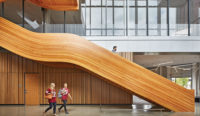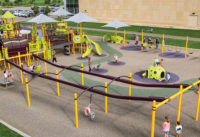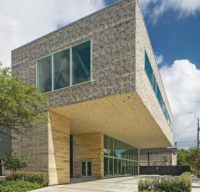In the 1960s and ‘70s, some may have believed that windows in schools only served to distract occupants, but today there’s a consensus among many architects that the natural light windows afford is beneficial to students, helping improve learning and attentiveness, instilling positive moods, and even supplying added Vitamin D. Of course, daylighting doesn’t mean haphazardly adding a curtainwall or window.
Often, “the biggest oversight is glare,” says Jeffrey Murphy, a founding partner of MBB. “We recommend careful sun simulation studies that can inform the design and orientation early on.” When planning elementary school PS330Q, for instance, his firm conceived upper hopper panels with white-fritted Pilkington glass in the south-facing classrooms to combat glare. Matte finishes for millwork surfaces, floors, and furnishings and a brise soleil by Architectural Louvers further mitigate the harsh reflections and light.
Marsha Maytum, principal of Leddy Maytum Stacy Architects concurs: “Getting enough light in a room is often less of a challenge. We’re interested in optimizing visual comfort.” In addition to carefully choosing surface finishes and orienting the openings, she points to solutions such as designing thin floor plates, daylighting from multiple sides to produce even light levels, and strategically using solar-control products. Demonstrating these tactics, Jacobs Institute at UC Berkeley features a glazed south elevation paired with a custom system of 42-inch-deep horizontal shading louvers. And the building’s east-west–oriented public spaces provide views but still minimize glare and solar heat gain via 6-inch-deep Aerolite vertical blades.
Ultimately, both firms emphasize that designers should consider the specific uses and activities of each school space in addition to orientation toward the sun to determine how best to harness and direct daylight. “The responsibility of the design team is to provide an appropriate solution for the space’s intended use,” says Maytum. “It’s counterproductive to provide a well-designed, day-lit space if those using it are going to close the shades and turn on artificial lights for the duration of the class.”






